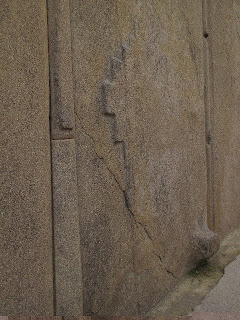Machu Picchu is not an easy site to get to. This probably has everything to do with the reason it was re-discovered in such great shape... the Spanish never found it. Since it is so remote, there are but two ways to get there: walk four days on the Inca trail (the way I always imagined getting to Machu Picchu), or ride a train to the town of Aguas Calientes and ride in a diesel bus up a narrow dirt road to the foot of the ruins. Since we had such a short period of time we had to go by train.
The atmosphere around Machu Picchu was more reminiscent of Epcot Center than the Amazon Basin. Just as I feared. It was a kind of tourist purgatory overflowing with trinket shops and beer gardens squeezed between the near vertical walls of the Urubamba River canyon. After such an inauspicious approach I was prepared to be disappointed by the ruins.
I was wrong.
No words or images can do justice to the feeling of standing on the ridge of Machu Picchu, catapulted as it is, thousands of feet above the tight oxbow of the Urubamba river that surrounds it on three sides like a moat. I won't attempt to share my shallow knowledge of the site and its construction here -- you'd be better served to read a book -- but I will post images with some semblance of captions.
The train pulling out of Urubamba
Pedro, superguide, was by mom's side every step of the way.

The quintessential view of Machu Picchu. If you turn your head 90˚ to the right, you will see the profile of a face formed by Huayna Picchu, the ridge behind the ruins. Coincidence? I think not.
The wall that knocked Hiram Bingham's socks off.

Double doorway near the Temple of the Sun. Notice the two different types of stone work -- the left side was part of a dwelling while the right was part of a holy temple. Also notice the anti-seismic angles of the door frame.
Two examples of the extraordinarily organic architecture used by the Inca, seamlessly incorporating the granite bedrock into their constructions.
Detail of the head of a condor carved into the bedrock above, and its outstretched "wings" below.
To the Inca the condor was a totem that helped souls bridge the gap from the world of the living to the realm of the Gods.

Steep terraces blanket the flanks of the ridge on all sides. Even though they look uniform, beneath the surface each of these terraces has three distinct layers for optimum irrigation and growing conditions. The first layer is gravel, next is sand, and the last layer is rich mud hauled up from the banks of the Urubamba river. It is difficult to imagine how much work and skill it must have taken to etch these earthworks into the steep granite cliffs.


Our friendly steward whips up the best Picso Sour in Peru (really!) while we head back to Cusco on the "Vista Dome" train.
The four hour ride from Aguas Calientes was broken up by a few traditional dance presentations and,
I kid you not, a fashion show of alpaca outerwear, complete with a pumping euro-techno soundtrack, modeled by the stewards and stewardesses who prepared our drinks.
Brother David trying valiantly to block out Didi's dramatic oral reading of "The Madoff Chronicles" as we steam through the Andes on the train back to Cusco.
UNESCO has placed Machu Picchu on the list of most endangered archeological sights, and I can see why. The Peruvian government has a curious habit of reconstructing ruins to make them look nicer, but in their fervor for tidiness they are likely erasing important information that could fill in the gaps of the stories of the people who made them. Additionally, the town of Aguas Calientes (whose name is now being changed to El Pueblo de Machu Picchu) is poorly equipped and situated for the hordes who come to see the place. The glory of Machu Picchu's location, preservation, and history are nearly equaled by the grotesque nature of the tourist circus surrounding it. There are some measures being taken to better preserve the ruins in their original state, and the number of visitors is limited per day, so not all the news is bad.
Even after having said all that, I was so amazed by the place that (perhaps a bit selfishly...) I can't wait to get back to it. Being there is such an astounding experience that I encourage all of you reading this to do the same.













































